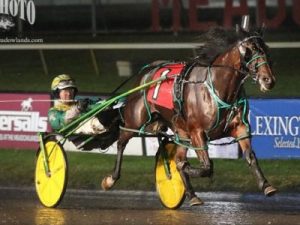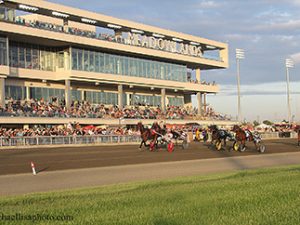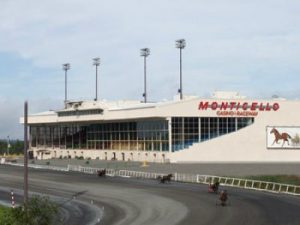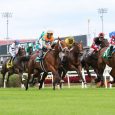By John Furgele

Shartin N – Photo courtesy of harnesslink.com
The stakes racing season is over in harness racing; it concluded when 9-1 long shot Shake That House prevailed in the $355,000 Progress Pace at Dover Downs on Nov. 27.
Stakes races dominate harness racing from late spring through the fall. There is the build-up to the Hambletonian, which comes early in the season. After that first Saturday in August, stakes races continue at various tracks throughout North America with the top horses visiting several of them. For top filly pacer and Horse of the Year candidate Shartin N; one week she’s racing at Plainridge Park (Massachusetts), a week later, the Meadowlands and then, it’s off to Harrah’s Philadelphia.
By December, it’s time for these horses to take a break and from now through late February-early March, rest will be in order. With these horses gearing down, it’s time for the “Winter Warriors” to gear up for the beginning of their season, which is referred to as the ‘Overnights.’
We call them overnighters because these are the horses that compete for the modest purses. There are no six-figure stakes races in the winter and the overnighters are competing for sums anywhere from $3,300 to, at best, $50,000. They’ll race each week and those that bet in the winter know where to find them; they know who’s hot and who’s not.
The overnighters started racing in November and will race through the spring, but it is the winter when they do their heavy lifting. Once purses (and the subsequent conditions) increase, many overnighters simply can’t compete. The best will head to Monticello, Yonkers and Freehold and places like Tioga and Vernon, but many will rest up in the summer and fall and gear up for another winter.
Tracks like Hoosier, Harrah’s Philadelphia and Pocono are done until March and April and in their place come tracks such as Buffalo, Cal Expo, Western Fair as well as those that race all year — Yonkers, Monticello, Northfield, Mohawk Park and The Meadows.
And, for those that think The Meadowlands is known strictly for the Hambletonian, Hambletonian Oaks and Meadowlands Pace, think again. Their winter overnight season features some of the best drivers and grittiest horses; with many coming in from Harrah’s and Pocono to compete over the winter. The bettors know this and handle often stays over $2 million each racing night.

Meadowlands Racetrack – Photo Courtesy of www.TheBigM.com
To put it simply, the overnighters are not the best horses; they’re not as good as those that race in the warmer months, but in many ways, they are the toughest; running week in and week out through the snow, cold and sleet, often providing the consistency that bettors desire.
Some of the best winter racing takes place at Pompano Park, on its smooth, sandy 5/8 mile track. With temps hovering in the 70s and 80s, it’s not a bad place to train and race at over the winter. And, with the same horses competing each and every week, handicapping — though never easy — becomes less confusing. Even though Pompano offers warm weather, the modest purses still keep the track in the overnight category.
Let’s take a look at a typical Monday winter card. Northfield, Yonkers, Monticello and The Meadows are open, but as 12-month tracks, they’re always open. Also open are Dover, Dayton, Pompano and Rosecroft. Come January, Rosecroft will be dark while the Dayton racing will shift to Miami Valley. With fewer tracks open, handicappers have more time to study, analyze and make what they hope are winning wagers.
Overnight racing can also save horses and as an example we look no further than the legendary trotter, Obrigado. This is a horse that has competed in some of the biggest races harness racing offers. The soon-to-be 11-year old is hoping to make a racing comeback and will use the winter to do so.
He last ran in 2018 and then, because of leg injuries, was going to be retired. Trainer Paul Kelley was looking for the right retirement home for the trotter, but while looking, brought him to his barn to “hang out” with his other horses.
Well, the 45-time winner began feeling better. The leg was scanned and showed signs of healing and when you’ve raced 92 times and earned $1.8 million, hanging around the paddock gets boring.
Kelley started jogging the horse, the leg healed and Obrigado was given a clean bill of health by the vets. Kelley now had a decision to make — where to race him.
If not for winter/overnight racing, we might not see a horse like Obrigado trot again, but because of it, he has returned to the track. On Sat. Dec. 7, he was one of seven entered in the $42,000 open trot at Yonkers.

Monticello Raceway – Photo courtesy of harnesslink.com
He made a move on the backstretch and was second at the three-quarter mark before race rustiness set in. He faded to sixth and was timed in 1:57.1. Kelley knows that the horse needs more races and will use the winter to get them. It might be at Yonkers, it might be at Freehold, but if you like harness racing, and in particular, winter harness racing, you have root for an old pro like Obrigado.
Speaking of old pros, Monticello Raceway is bidding farewell to pacers and trotters on Dec. 27 in what they are calling the Au Revoir Trot and Pace.
In harness racing, horses cannot race past age 14 and because all horses celebrate their birthdays on Jan. 1, this race will be the last for 14-year olds before they head off to retirement farms, beaches and early senior citizen dinners.
In true overnight fashion, the purse for each race is $5,000. Eric Warner, Monticello’s longtime racing secretary, has been taking phone calls about the races and believes that both the pace and trot will have full-fields.
Last year, a race for 14-year old pacers was contested on Dec. 31 with Mayflower Moonshine besting a field of six in 1:59.4.
It is time for the overnighters to rise up and take center stage. They’ll race hard, they’ll race often and they’ll keep your attention over the long, cold winter.


